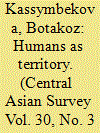| Srl | Item |
| 1 |
ID:
104057


|
|
|
|
|
| Publication |
2011.
|
| Summary/Abstract |
This article examines everyday realities of the state-building process in early Soviet Tajikistan. The work concentrates exclusively on the experiences of 'European' state workers, that is, their uncertain position as 'imperialists', and points to nuances of the early Soviet state building. By observing the mundane micro-level experiences of the state actors from the European parts of the Soviet Union in Central Asia, the author proposes to treat sentiments of state actors as important indicators of the Soviet statehood practices and poses the following question: why did the European state workers feel isolated, unsupported and even helpless and how can we understand their experiences as an integral part of the Soviet empire state-building process? The author argues that individuals' power and powerlessness was at the core of the early Soviet political structure since individual state representatives were to palliate institutional and legal deficiencies - a task that required enormous physical and emotional sacrifices and also included personal responsibility for anything that might have been deemed by the top as a failure.
|
|
|
|
|
|
|
|
|
|
|
|
|
|
|
|
| 2 |
ID:
107538


|
|
|
|
|
| Publication |
2011.
|
| Summary/Abstract |
This article re-evaluates the history of internal resettlement in Soviet Tajikistan in the 1920s and early 1930s. Rather than a purely 'economic' measure, as the policy has thus far been identified by historians, the programme of internal resettlement had political and military rationales to secure the republic's southern plains bordering Afghanistan. These territories were considered by Soviet leaders to be insecure and under threat. By pointing to the role of ethnic categories in organizing the resettlement and the violent manner in which the policy was conducted, the author analyses state leaders' attempts to ethnicize territories and populations in order to identify, naturalize and secure allies, within and beyond Tajikistan. Tajikistan's resettlement had internal as well as foreign-policy objectives to secure the Soviet Union's border regions as well as to spread Soviet influence abroad.
|
|
|
|
|
|
|
|
|
|
|
|
|
|
|
|
| 3 |
ID:
181817


|
|
|
|
|
| Summary/Abstract |
The article reviews major frameworks for re-evaluating Soviet Central Asian history in anglophone scholarship after the collapse of the Soviet Union. It tackles recent popular concepts such as ‘modernity’, ‘development’ and ‘modernization’ for analysing the Soviet past in the region. It questions the analytical value of the terms as well as their ability to capture the complexity of social, political and economic changes that Central Asia underwent in the course of seven decades between the October Revolution and the dissolution of the USSR. The article furthermore provides an overview of novel themes and approaches in the field and suggests themes for further research.
|
|
|
|
|
|
|
|
|
|
|
|
|
|
|
|
| 4 |
ID:
152005


|
|
|
|
|
| Summary/Abstract |
Stalin never personally visited Central Asia, yet the region underwent major transformations during the period of his rule. This special issue is not devoted to Stalin’s personal ideas about the development of Soviet Central Asia. Rather, it is an attempt to understand those who experienced and co-shaped that period in various Central Asian contexts and how those experiences figured in the Stalinist regime overall. Shifting the focus away from the study of Moscow’s ideological ambitions and top-down national construction, the authors explore the everyday experiences ‘on the ground’ in order to (re)discover the place of Central Asia in the larger map of Stalinist governance.
|
|
|
|
|
|
|
|
|
|
|
|
|
|
|
|